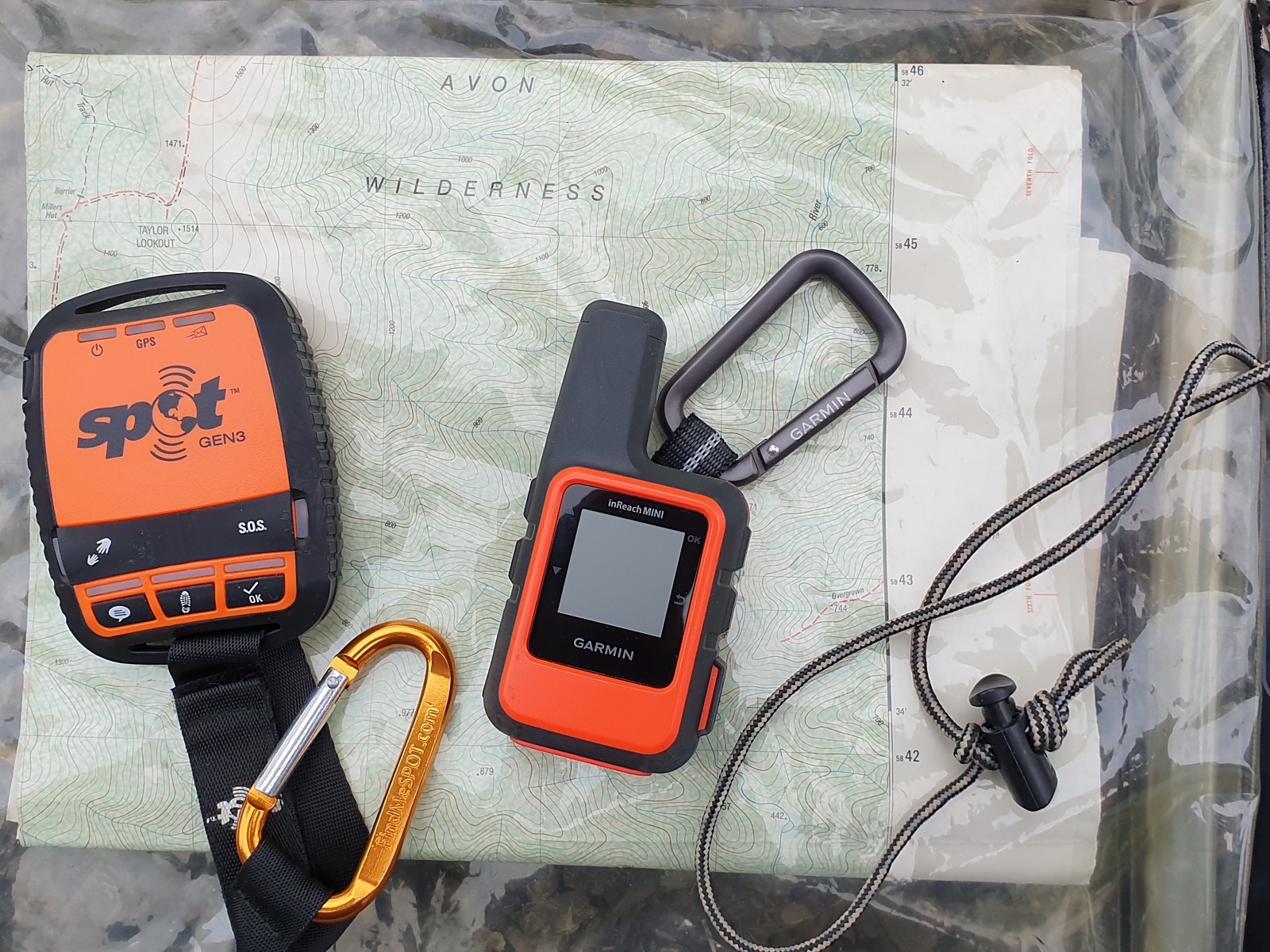Reading Time: 3 minutes
Satellite tracking devices (with SOS function) sit between a Satellite Phone and a PLB, with some of the advantages of both.
These devices communicate via satellites, the same as a sat phone, so they will work anywhere with a clear sky view. There are various brands and models available. All have an inbuilt GPS chip. Trackers cannot do voice calls.
Key features:
- “SOS” button that operates, in effect, same as a PLB, sending an “SOS” message with a GPS location.
- “OK” button that sends an “OK” message to pre-set email or mobile phone numbers, with a GPS location.
- Tracking function which periodically sends the GPS location to a website, which the Trip Contact, family and friends can access to check on the progress of the group by the GPS track log.
Most brands/models have the capability to send text (SMS) messages, but some models are limited to a small number of pre-set messages.
At the time of writing (2019), there are two brands of trackers with SOS functions available in Australia: Find Me SPOT and Garmin inReach. Each produce various models and offer various monthly plan options.
NOTE: Carrying a mobile or satellite phone, PLB or tracker with an SOS button does NOT eliminate the need for a Trip Emergency Contact.
Advantages of a satellite tracker with SOS
- Small and lightweight.
- SOS button (functions similar to a PLB).
- The tracking function is particularly useful for solo walkers as it gives a regular location update to family and friends. Any delay or change of route is apparent.
- The tracking function provides current location even if the solo user is incapacitated and unable to operate the SOS button.
- Provides a level of communication through the “OK” message which reduces unnecessary 000 calls by concerned family members or trip contact, for example if the group is delayed. (Note the disadvantage of the “OK” function below.)
- Some models can send and receive text (SMS) messages – two way communications. Details of an emergency or change of plan can be communicated without the high cost of a satellite phone. There is also confirmation that the messages have been received.
- Some models can also receive weather forecasts (at a cost).
Disadvantages of a satellite tracker with SOS
- Transmit power for messages, including the SOS, is less than a PLB or sat phone.
- The tracking function consumes battery power so a means to regularly recharge or replace batteries is required. On an extended trip, this must be planned.
- Running cost. A monthly or casual service plan is required.
- A prearranged daily “OK” message is reassuring for family, but can be a problem if no “OK” is received. That may be due to flat batteries, an oversight or the message was never received by the satellite. Should the family contact emergency services? This must be discussed and agreed prior to the trip.
- Some models utilise a mobile phone via bluetooth to make use of the phone’s touch screen for messages. This means two devices need to be kept charged.
NOTE: Satellite coverage and time for the satellite to receive messages differs between devices and networks.
Activating the satellite tracker SOS function
The SOS function (button) should only be activated in a situation of grave and imminent danger; a life threatening situation. It’s the same as activating a PLB.
On receiving the SOS message and location, the commercial provider of the tracking device service (typically based in the USA) will:
- Notify the Rescue Coordination Centre (RCC) in Canberra
- The RCC will notify the relevant State Rescue Coordination Centre.
This is the same process as for a PLB activation.
- An emergency services response will be initiated.
- The registered owner and emergency contacts recorded for the device will be contacted to confirm that the activation is genuine and to obtain trip details.
Using a satellite tracking device effectively
Register, setup and configure the satellite tracker with care:
-
- Choose the appropriate service plan.
- Set a longer track log interval so that the battery will be not be unnecessarily drained.
- Register the device owner, trip and family contacts (via provider website)
- Define suitable preset messages.
- Test the tracking function.
- Ensure family and the Trip Contact have the web link to the track log.
- Ensure all useful and emergency contacts are stored in the unit, if that is an option.
Ensure at least two group members know how to:
-
- Operate the device including the SOS button and tracking function.
- Send messages (and receive, if the model has that function.)
General points:
- Ensure the instructions are kept with the device.
- Ensure a clear sky view when operating.
- Store in a secure waterproof pouch or container.
- Keep the tracker warm to maximise battery effectiveness.
- Carry spare batteries or a reliable means of recharging.
Note: this section intentionally avoids excessive technical detail.
See also


